Bhutan – Beautiful beyond one’s belief
Day 01: Arrive Paro by Druk Air & transfer to Thimphu
The flight to Paro is one of the most spectacular in entire Himalayas. Whether flying along the Himalayan range from Kathmandu or over the foothills, the journey offers fascinating views and an exciting descent into the Kingdom. Bhutan’s first gift as you disembark from the aircraft will be cool, clean fresh mountain air. After immigration formalities and baggage collection, you will be met by our representative, and afterwards drive to Thimphu, the capital town of Bhutan with en-route stop at Chuzom, the confluence of Thimphu and Paro rivers. Three different style of stupas ; Tibetan, Nepalese and Bhutanese adorn this confluence. On arrival, in Thimphu check-into the hotel. The capital town of Bhutan and the centre of government, religion and commerce, Thimphu is a unique city with unusual mixture of modern development alongside ancient traditions. With the population of about 1,00,000 it is perhaps still the world’s only capital city without a traffic light. Evening an exploratory walk around Thimphu main street and market area. Overnight at the hotel in Thimphu.
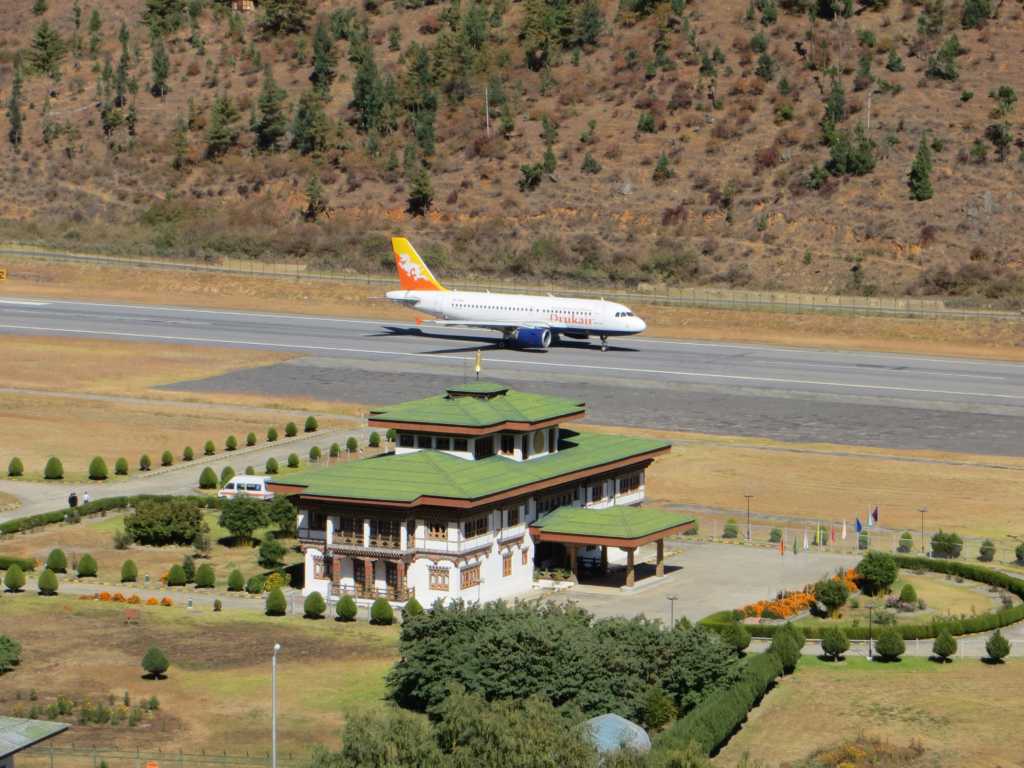
Day 02: Thimphu
After breakfast, drive to Buddha Point (Kuensel Phodrang). Located at a short drive from Thimphu city centre, visitors can get a good overview of the Thimphu valley from the Buddha point (Kuensel Phodrang). You can pay your obeisance and offer prayers to the Buddha, the largest statue in the country and then walk around and take a glimpse of the valley.
Then, visit King’s Memorial Chorten continuously circumambulated by people, murmuring mantras and spinning their prayer wheels. Construction of this landmark was the idea of Bhutan’s third king, His Majesty Jigme Dorji Wangchuk (“the father of modern Bhutan”) who has wished to erect monument to world peace and prosperity. Completed in 1974 after his untimely death, it serves both as a memorial to the Late King and as a monument to peace.
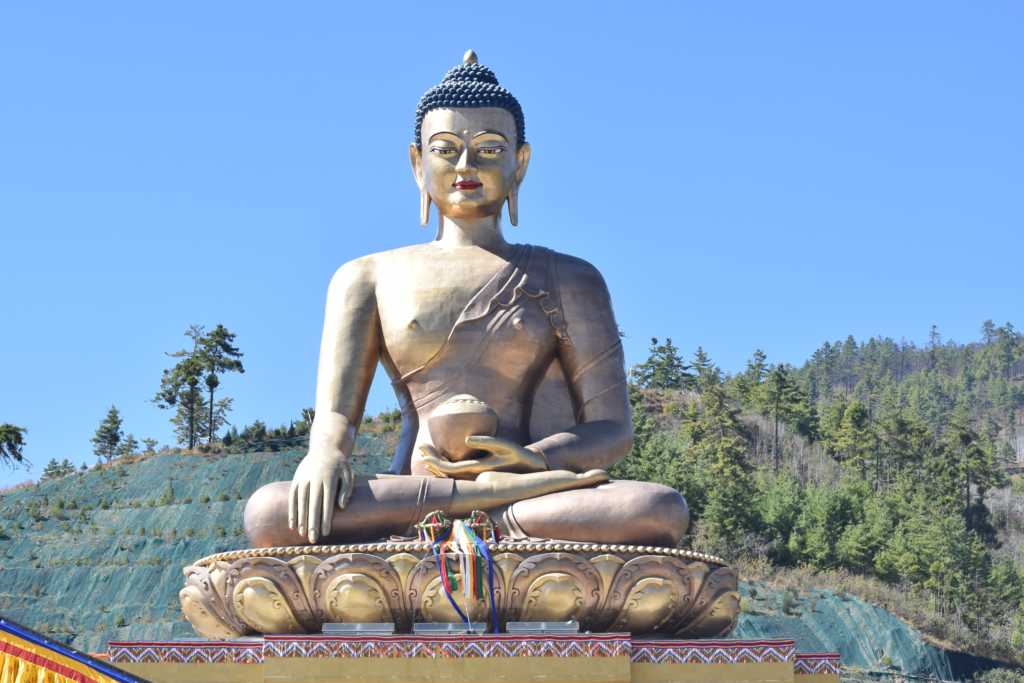
Afterwards visit to:
Textile Museum: is worth a visit to experience the living national art of weaving. Exhibitions introduce the major weaving techniques, styles of local dress and textiles made by women and men.
Folk Heritage Museum: The Museum is dedicated to connect people with the rich Bhutanese Folk heritage and rural history through exhibits, demonstrations, educational programs and documentation of Bhutanese rural life.
National Library: The history of Bhutan lies imprinted in archaic texts, which are preserved at the National Library. Besides thousands of manuscripts and ancient texts, the library also has modern academic books and printing blocks for prayer flags.
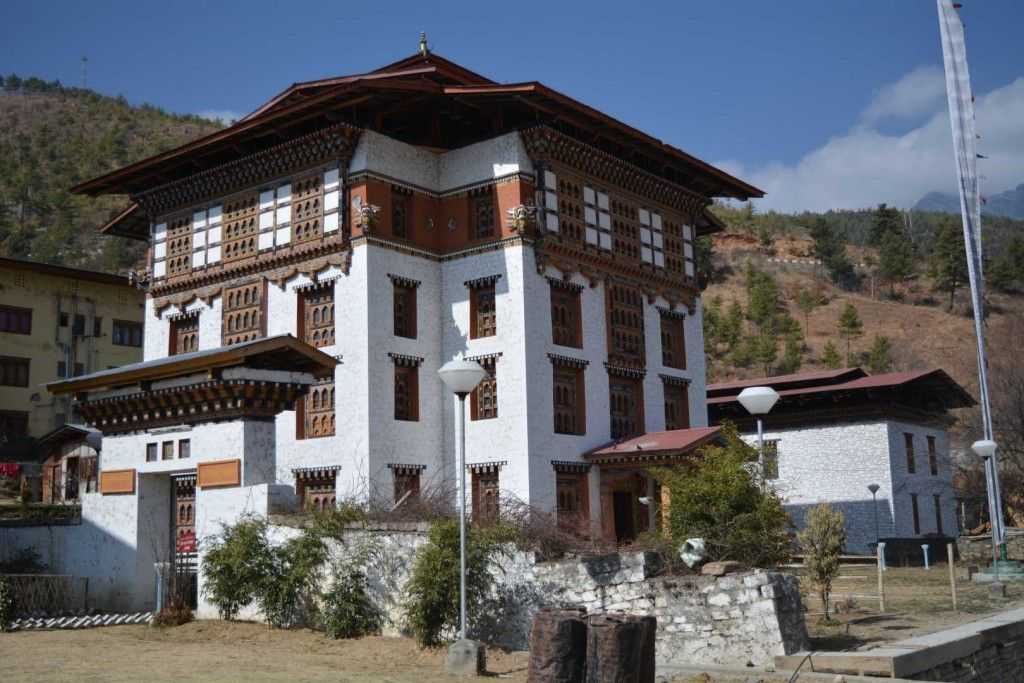
Institute for Zorig Chusum: Commonly known as Arts & Crafts School or Painting School, the Institute offers a six-year course on the 13 traditional arts and crafts of Bhutan. On a visit, one can see students learning the various skills taught at the school.
Then, drive to Takin Preserve. The Takin is national animal of Bhutan, and looks like a cross between a cow and goat. Later in the afternoon visit Trashichhoedzong, ‘fortress of the glorious religion’. This is the center of government and religion, site of monarch’s throne room and seat of Je Khenpo or Chief Abbot.
Built in 1641 by the political and religious unifier of Bhutan, Shabdrung Ngawang Namgyal, it was reconstructed in 1960s in traditional Bhutanese manner, without nails or architectural plans. Evening time can be spent strolling through the government-run Handicrafts Emporium and local crafts bazaar, to browse through example of Bhutan’s fine traditional arts. Here you can buy hand-woven textiles, thangkha paintings, masks, ceramics, slate and wood carvings, jewelry, interesting items made from local materials. Overnight at the hotel in Thimphu. (Altitude 2,320 m).
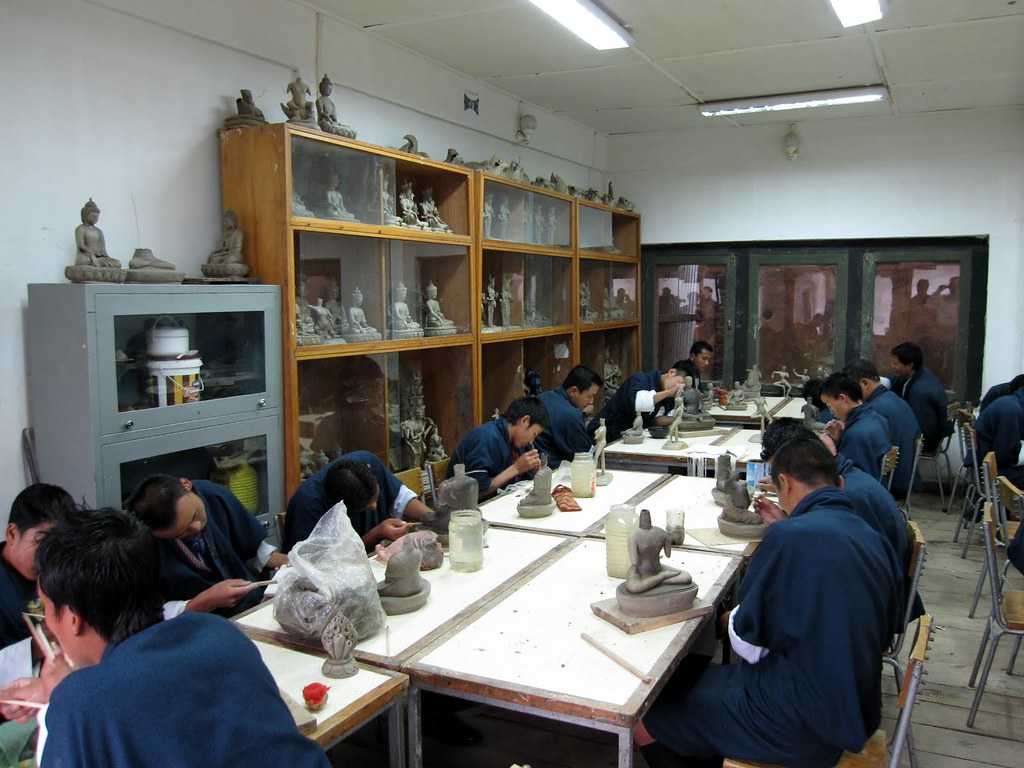
Day 03: Thimphu – Punakha & Wangduephodrang (75 km, approx. 3 hours drive)
After breakfast, drive to Punakha / Wangduephodrang across Dochu La. Located at a height of 3,088m/ 10,130 ft, Dochula is a scenic location with chorten, mani wall, and prayer flags which decorate this highest point on the road. If skies are clear, it may be possible to see the following peaks from this pass in the order left to right: Masagang (7,158m), Tsendagang (6,960m), Terigang (7,060m ), Jejegangphugang (7,158 m), Kangphugang (7,170 m ), Zongphugang (7, 060 m ), a table mountain that dominates the isolated region of Lunana – finally Gangkar puensum, the highest peak in Bhutan at 7,497m.
Afternoon visit Punakha Dzong or (Palace of Great Happiness), built in 1637 by Shabdrung Ngawang Namgyal, at the junction of the Phochu and Mochu rivers. This majestic dzong served as both the religious and the administrative center of Bhutan in the past. It measures some 600 by 240 feet and has a six-story, gold-domed tower. Inside are courtyards and religious statuary that hint at the depth of history and spiritual tradition embodied here. Your guide will illuminate your understanding of this intricate culture that is exotic to us, though long established here.
Later in the day excursion to Chimi Lhakhang. The Chimi Lhakhang, situated on a hillock in the centre of the valley, is also known as the temple of fertility. It is widely believed that couples who do not have children and wanting one, if they pray at this temple, they are usually blessed with a child very soon. A walk through the village near the temple will give you rare glimpses into the daily life and lifestyle of the villagers. Overnight at the hotel in Punakha / Wangduephodrang . (Altitude 1,300m).
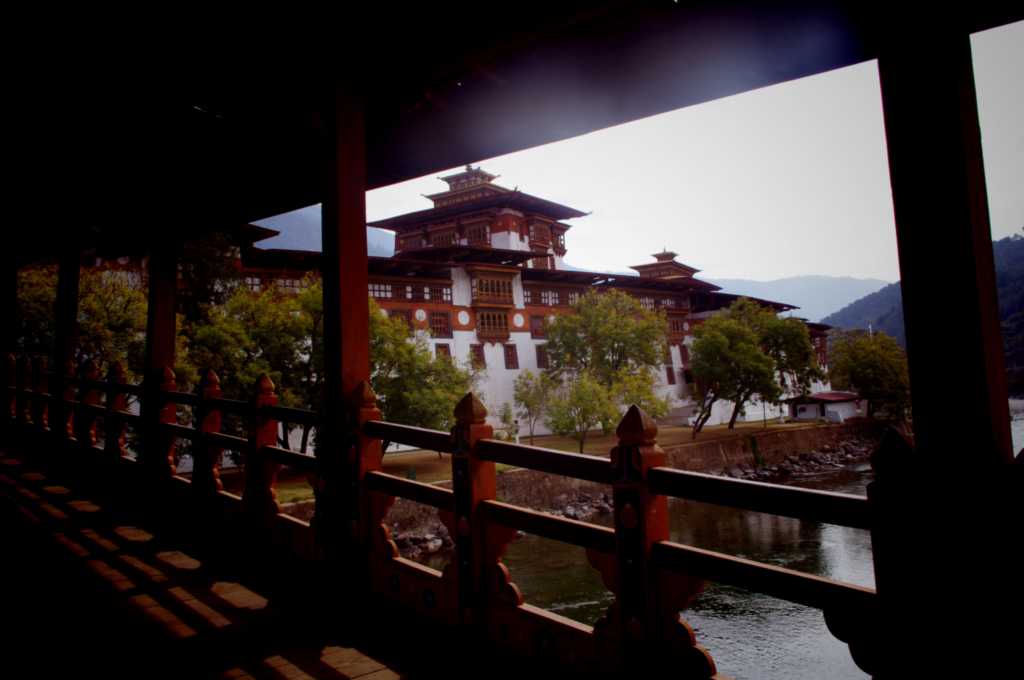
Day 04: Punakha & Wangdue phodrang
After breakfast, a beautiful hike (total about 2 hours round trip walk) takes you to the regal Khamsum Yuelley Namgel Chorten, which was built by the Queen Mother of Bhutan to remove negative forces and promote peace, stability and harmony in the changing world. The Chorten dominates the upper Punakha Valley with commanding views across the Mo Chhu river and up towards the mountainous peaks of Gasa and beyond.
Afternoon visit to Sangchhen Dorji Lhuendrup Lhakhang (nunnery). Perched on a ridge amid pine trees and overlooking valleys of Punakha and Wangduephodrang, gleams the magnificent structures of Sangchhen Dorji Lhuendrup Lhakhang(Temple). The temple houses a 14-foot main bronze statue of Avalokiteshvara (Chenrigzig chagtong chentong). Other statues include those of Guru Padmasambawa, Gautama Buddha, Zhabdrung Ngawang Namgyel, Tsela Namsum, the 21 Taras and Tsepamay (Buddha of longevity). The Avalokiteshvara statue, one of the biggest in the country, was the handiwork of entirely local Bhutanese artisans.
Later excursion to Talo village. The village of Talo (alt. 2,800m) which is scattered along the hill slopes, known for its cleanliness and hygiene among Punakha villages. Talo Sangnacholing is built on a plateau and has majestic view of surrounding villages. The beautiful farm houses of the village have its own flower gardens and on the hill slope corns and sweet peas are grown in abundance. Later in the afternoon drive back to Punakha / Wangduephodrang, for overnight stay. (Altitude 1,300m).
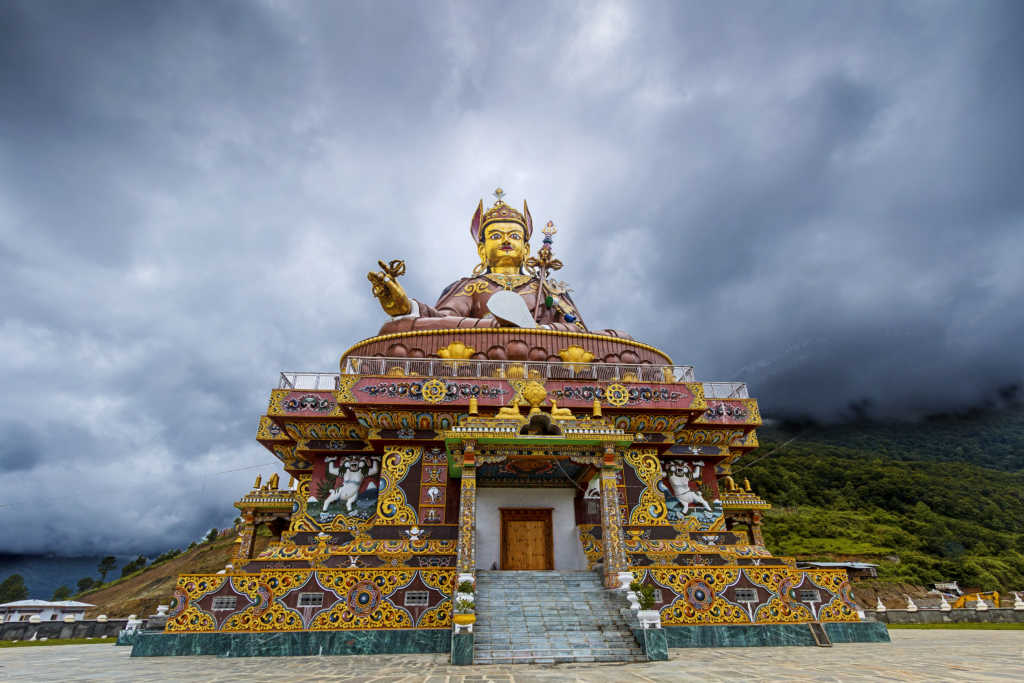
Day 05 : Punakha & Wangduephodrang – Paro (125 kms, approx. 4.1/2 hours drive)
After breakfast drive back to Paro descending back down from Dochu La, follow the way back up the dramatic Wang Chhu and Paro Chhu river valleys, before crossing through Paro town towards the north end of the valley. En route visit Simtokha Dzong, one of the oldest fortress of the country and known as the place of profound tantric teaching. This dzong now houses a school for the study of the Dzongkha language. Later in the day after checking into hotel, proceed to visit Ta Dzong, originally built as Watchtower, which now houses National Museum. The extensive collection includes antique thangkha paintings, textiles, weapons & armour, household objects and a rich assortment of natural and historic artifacts. Then walk down the trail to visit Rinpung Dzong, meaning (“fortress of the heap of jewels”), which has a long and fascinating history. Along the wooden galleries lining the inner courtyard are fine wall paintings illustrating Buddhist lore such as four friends, the old man of long life, the wheel of life, scenes from the life of Milarepa, Mount. Sumeru and other cosmic Mandala. Overnight at the hotel in Paro. (Altitude 2,280m).
Day 06 : Paro
After breakfast excursion to Taktshang Monastery (approx 5 hours round trip walk). It is one of the most famous of Bhutan’s monasteries, perched on the side of a cliff 900m above the Paro valley floor. It is said that Guru Rinpoche arrived here on the back of a tigress and meditated at this monastery and hence it is called ‘Tiger’s Nest’. This site has been recognized as a most sacred place and visited by Shabdrung Ngawang Namgyal in 1646 and now visited by all Bhutanese at least once in their lifetime.
OR
After breakfast, excursion to Dzongdrakha Goempa. Often called as mini Takstang, Dzongdrakha is a cliffside temple complex on the western side of the Paro Valley. Four shrines make up the complex, dedicated to Drolma (Tara), Tsheringma (Goddess of Longevity), Guru Rinpoche and the Buddha of the Future, Maitreya. Local oral tradition states that when Guru Rinpoche first came to Bhutan, he came from Nepal, first landing at Drakarpo, and then Dzongdrakha before arriving at Taktshang (Tiger’s Nest) farther north up the valley. Located approx 20 minute drive from Paro, these temples are built on a cliff above Bondey village but the walk is not as strenuous as Taktshang. From the road, it take only about 30 minutes walk to reach here. The Dzongdrakha village has numerous temples and is known for most of their men being either fully ordained monks or gomchens (lay monks who don’t take vows of celibacy). Ironically it is the women who work in the fields and are the bread earners unlike in any other part of the country. Afternoon drive to the base of Drukgyel Dzong, a ruined fortress (currently under restoration) where Bhutanese warriors fought Tibetan invaders centuries ago. The snowy dome of sacred Chomolhari, ‘mountain of goddess’ can be seen in all her glory from the approach road to the Dzong. Also visit the 7th century Kyichu Lhakhang, one of the 108 temples built in the Himalayas by Tibetan King, Songtsen Gampo. The building of this temple marks the introduction of Buddhism in Bhutan. Evening an exploratory walk around main street and market area. Overnight at the hotel in Paro. (Altitude 2,280m).
Day 07 : Paro (Excursion to Haa valley)
After breakfast, take full day excursion to Haa valley. Adjoining the districts of Paro, Chhukha and Samtse, Haa valley is one of the most picturesque places in the Kingdom, spread over an area of 1706 sq. km. During pre-Buddhist era, Haa valley was known for its animist tradition. Inhabitants then were enthused in offering animal blood to their local deities. Such animist belief however was transformed into peaceful Buddhist tradition in the 8th century by Guru Padsambhava. The valley is also unparalled in Bhutan in terms of the diversity of the folk culture, legends and shamanistic rituals. The exotic Haa valley was opened for the first time to foreign tourists only in 2002. En route to Haa valely, take a short stop at Chelela pass. At an elevation of 3,988 meters, Chelela is considered to be one of the highest motorable passes in Bhutan. About an hour’s drive along a thickly-forested road, this pass is a botanical paradise. The pass provides stunning views of the sacred mountain Jumolhari and Jichu Drake. It is also marked by hundreds of prayer flags fluttering in the wind. During season, here, visitors can see cascades of wild roses, purple and yellow primulas and swathes of deep blue iris covering the forest cover. The top of the pass bloom with rhododendrons in a variety of colours-pale pink, deep pink, burnt orange, mauve, white and scarlet, in season.
On arrival in Haa valley, visit the famous monasteries of Lhakhang Karpo (White temple) followed by Lhakhang Nagpo (Black temple). As per the legends, King Songtsen Gampo released a black and a white pigeon in order to build temples. The white pigeon landed on mountains of Chenrizi of towering Rigsum where Lhakhang Karpo was built. On the other hand black pigeon landed on north – that is Lhakhang Nagpo. Today the temple is called Nagpo or black built on the site where black pigeon landed. Both the temples are much revered and must visit.
The Ha Wangchuklo Dzong built in 1915 after the Dumchog Dzong was razed to the ground by fire is worth exploring, standing in the midst of lush greenery with its beautifully painted walls. Later explore Haa town and its market area and then return to Paro for overnight stay. Overnight at the hotel in Paro. (Altitude 2,280m).
Day 08 : Depart Paro
After early breakfast at the hotel, drive to the airport for flight to your onward destination. Our representative will help you with exit formalities and then bid you farewell.
-
IncludedLocal Sightseeing at ThimpuLocal Sightseeing at PunakhaLocal Sightseeing at ParoAll the tours and transfers08 days stay at 3 star propertyDaily breakfast
-
Not IncludedInternational flightGSTThings not mentioned in itineraryAirport taxes if any
 We aim to provide Optimum Travel Services and providing a One-Stop-Solution to our customers, Our Team comes together each day to design a trip that offers the single most comprehensive travel experience to our customers.
We aim to provide Optimum Travel Services and providing a One-Stop-Solution to our customers, Our Team comes together each day to design a trip that offers the single most comprehensive travel experience to our customers.